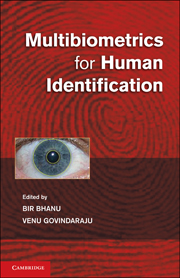Preface
Published online by Cambridge University Press: 25 October 2011
Summary
In today's security-conscious society, biometrics-based authentication and identification have become the focus of many important applications because it is believed that biometrics can provide accurate and reliable identification. Biometrics research and technology continue to mature rapidly, given pressing industrial and government needs and the strong support of industrial and government funding.
However, many of the applications warrant higher accuracy performance, which is not feasible with a single biometric today. It is widely believed that fusing multiple biometrics can also enable indexing of large databases and enhance coverage of the part of the population that is not able to provide any single biometric. Multiple biometrics is naturally more robust against spoof attacks as well, because hackers have to contend with more than one biometric.
This book addresses a broad spectrum of research issues ranging from different sensing modes and modalities to fusion of biometrics samples and combination of algorithms. It also covers theoretical and large-scale empirical studies on sensor fusion techniques in the context of biometrics authentication, identification, and performance evaluation/prediction.
As the number of biometrics architectures and sensors increases, the need to disseminate research results increases as well. Since 2006 we have organized a series of high-quality Annual Biometrics Workshops under the auspices of the IEEE Computer Society Conference on Computer Vision and Pattern Recognition. This series has emerged as the premier forum for showcasing cutting-edge research from academia, industry, and government laboratories.
- Type
- Chapter
- Information
- Multibiometrics for Human Identification , pp. xiii - xivPublisher: Cambridge University PressPrint publication year: 2011

